Oil futures settled lower Monday as investors eyed U.S. and global economic data for clues to the outlook for energy demand.
A reading on the New York Fed’s Empire State business conditions index released Monday revealed the first increase in activity in five months. That pointed to strength in the U.S. economy, but also raised the potential for more Federal Reserve interest-rate hikes to combat inflation.
Meanwhile, data on industrial output from China, and on the eurozone manufacturing and services sector are due out this week.
Price action
-
West Texas Intermediate crude for May delivery
CL00,
-0.34%CL.1,
-2.36%CLK23,
-2.36%
fell $1.69, or nearly 2.1%, to settle at $80.83 a barrel on the New York Mercantile Exchange. -
June Brent crude
BRN00,
-0.30%BRNM23,
-0.30%,
the global benchmark, declined $1.55, or nearly 1.8%, to settle at $84.76 a barrel on ICE Futures Europe. -
Back on Nymex, May gasoline
RBK23,
-0.03%
fell 2.2% to $2.77 a gallon, while May heating oil
HOK23,
-0.25%
fell 0.9% to $2.61 a gallon. -
Natural gas for May delivery
NGK23,
-2.27%
rallied by 7.6% to $2.28 per million British thermal units, extending their gains after posting a 5.1% rise last week.
Market drivers
A “shockingly strong” Empire State Manufacturing Index reading Monday helped to lift the odds of an interest-rate hike by the Federal Reserve in May, said Tyler Richey, co-editor at Sevens Report Research.
The New York Fed’s Empire State business conditions index, a gauge of manufacturing activity in the state, jumped 35.4 points in April to 10.8, the regional Fed bank said Monday. The index for new orders soared 46.8 points to 25.1 in April.
That data “poured some cold water on the recent rise in [economic] ‘soft landing’ hopes, which were the reason for oil’s break higher last week,” Richey told MarketWatch.
Strong economic data traditionally has meant strong oil and refined product demand, he said. However, with the yield curve “inverted to historic levels and sentiment towards the banking system still fragile, the threat that more rate hikes by the Fed either ‘breaks something’ in the financial markets or pushes the economy into a deep recession remains a very real threat to energy demand in the quarters ahead.”
“With the yield curve “inverted to historic levels and sentiment towards the banking system still fragile, the threat that more rate hikes by the Fed either ‘breaks something’ in the financial markets or pushes the economy into a deep recession remains a very real threat to energy demand in the quarters ahead.” ”
At the same time, traders have shown concerns about a potential slowdown in economic activity. Data released last week showed sales at U.S. retailers dropped 1% in March and U.S. wholesale inflation in March posted its biggest decline in almost three years.
Some traders believe that the U.S. economy is going to continue to slow down further, said Naeem Aslam, chief investment officer at Zaye Capital Markets.
“This is limiting the upside for oil prices, and we see selling pressure building up,” he told MarketWatch.
For now, oil prices are “more likely to grind to the downside, and we may see crude oil moving below the $80 handle,” with a move toward the $78 price handle possible, said Aslam.
However, traders know that the Organization of the Petroleum Exporting Countries is also “very active in the market and is not going to allow a run on prices,” he said.
Saudi Arabia and its OPEC+ allies in early April announced production cuts totaling around 1.16 million barrels a day beginning in May and running through the end of the year. Russia, meanwhile, said it would extend a cut of 500,000 barrels a day through year-end.
Coming up, March industrial output data from China on Tuesday will include domestic refining activity, noted strategists at ING, in a Monday note, while broader markets will pay close attention to first quarter Chinese gross domestic product data with the market expecting a year-over-year number of around 3.9%. China is the world’s largest energy consumer.
Aslam said economic data out of Europe is most important for traders. The S&P Global Flash Eurozone Composite Index, which measures the activity of the eurozone manufacturing and service sectors, is set for release on Friday.
Natural-gas futures, meanwhile, rallied Monday as “revised weather forecasts that show colder temperatures in the extended time frames bolster demand expectations,” said Sevens Report’s Richey.
Natural-gas futures have bounced off the $2 area multiple times so far this year, he said, but looking further into the future, Monday’s rally “really only dampens the bearish case and shifts the price outlook more neutral, with a broad trading range between $2 and $3 potentially forming,” Richey said.
Read the full article here




